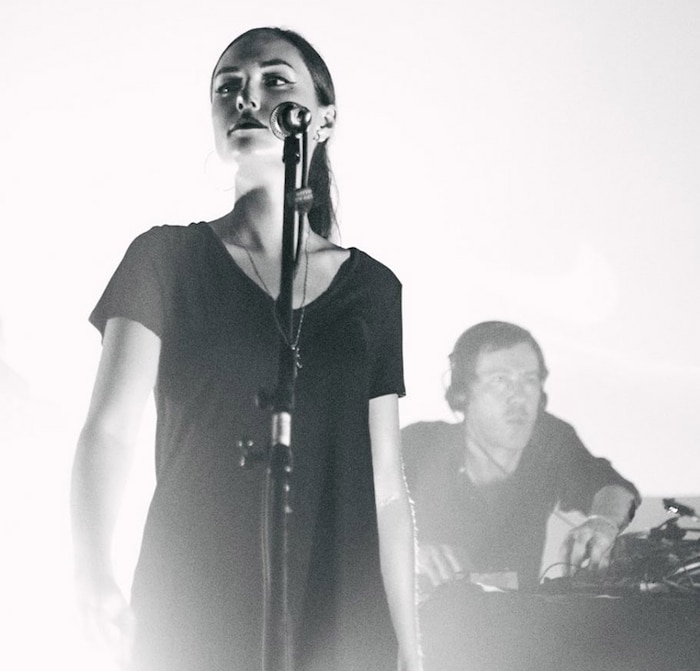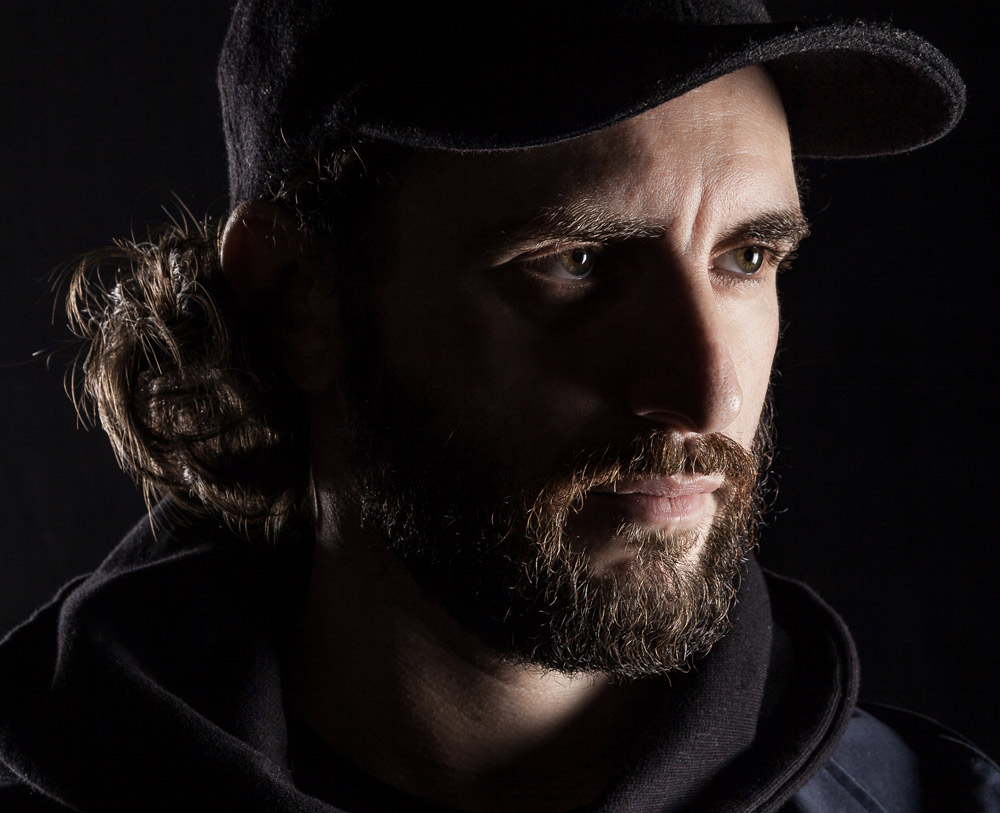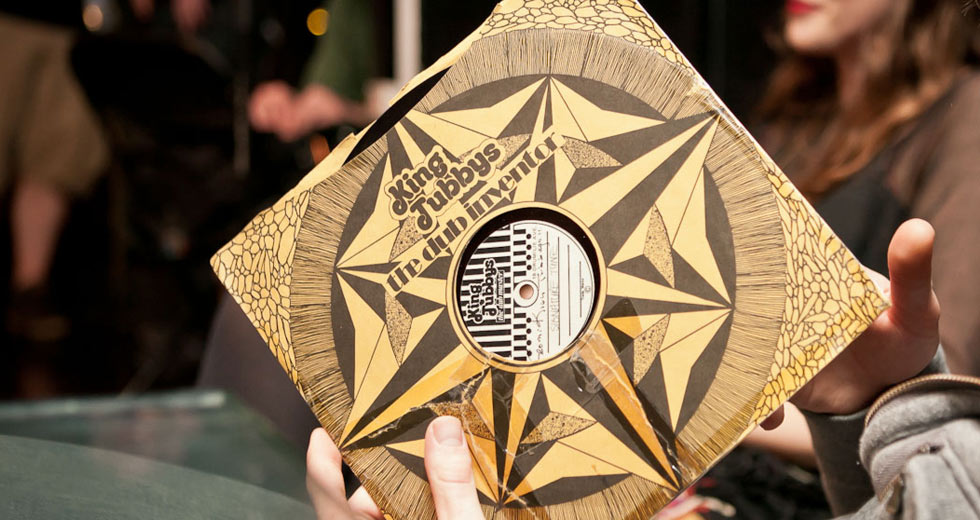Richard Fearless and Sasha Grey on Their Musical Collaboration
The polyglot producer otherwise known as Death In Vegas in conversation with his most recent musical foil
UK producer Richard Fearless has spent the past two decades infusing various strains of dance music with the gritty spirit of rock & roll via his Death In Vegas project. For the album Transmission, he decided to take a new route and found a creative sparring partner in actress, musician and adult entertainment star Sasha Grey. Taking inspiration from noirish avant-garde film, Fearless’s work has frequently been featured in film and game soundtracks, so it’s perhaps no surprise he would find a kindred spirit in Grey, an iconic former porn actress who has also acted in films like Steven Soderbergh’s The Girlfriend Experience as well as performing in aTelecine, an industrial music band that has been described as “experimental goth.”
This conversation with Fearless and Grey, taken from their Fireside Chat with Hanna Bächer on RBMA Radio, finds the pair discussing their early experiments in making music as individuals, as well as the emotional freedom they felt throughout their collaboration.

From your early musical experiences, was there any specific life or performance situation or a record where you could say, “This particular track, I heard it and then my life changed thanks to that”?
Richard Fearless
It was just music in general, particularly where I was born, right in the north of Zambia in a mining town. There was no TV, because it was all Afrikaner TV during apartheid, so my dad didn’t want any South African TV on. My dad was really into American big bands. He brought all his jazz records. My mum was a kind of pot-smoking art teacher. All her local friends got her into Congolese music, and in the ’70s Zambia was really vibrant; Witch and all these really pretty out-there Zamrock bands.
The radio went on at lunch, but the rest of the day the record player was on. Then both my sister and I got really into the power of selecting the record, and what it would do and how it could change. Trying to get your parents’ approval, because dad was really into dancing. It was a very interactive part of the house, the power of selection. I think it’s still pretty much what I’m doing.
Sasha, what was the music played in your home when you were a child?
Sasha Grey
Even though we come from completely different backgrounds, I feel like we both had this luxury of many different influences around us from our family. My siblings are older than me. My dad played classic rock and blues. My mom, dance and classical music. My brother, funk, soul, gangster rap, and my sister loved East Coast hip-hop.
In high school I started spending a lot of time in San Francisco, when I could get away. I got really bored at school. I was already a year ahead so I put myself in homeschooling, which is usually the opposite. In America, if you’re a homeschooled kid, you’re always kind of a weirdo, an outcast, or your parents are just crazy. I think it can be really beneficial, and for me it was, because I was able to get my school work done, finish and then explore my other artistic interests. That’s where a lot of my time was spent, discovering different bands and music in San Francisco.
Richard, I wanted to ask about the first two Death In Vegas records, before Tim Holmes joined the group.
Richard Fearless
I did the first album Dead Elvis when I was at art college. It was done with someone who lived in a house with the girl I was going out with, and he had a studio. He was a BBC engineer and it was done when he was available, so it took about three years. It was like, “We can do three hours on Tuesday night.” It was quite a frustrating experience. I didn’t really know what I was doing. I’d worked in record stores when I was a teenager, and I put on club nights when I was quite young, but I got signed off one single, a five-album deal. It was the first record I made, then I found myself having to deliver this album.
I was just learning. I didn’t really understand gear and equipment and stuff. We didn’t get on massively, and it wasn’t a great experience. The next record I used the money on this engineer I really liked working with. I decided I was going to build a studio, and rather than pay him I would give him a percentage. Like, “Come on board, it’s my band, but you work on it with me full-time.” That was when I did The Contino Sessions.
I got a guy who was one of my best friends at college to do all the artwork with me, then I got a friend of mine who was a filmmaker in another room. I guess the inspiration was Warhol, the whole Factory system and that way you can work on more than one project if you’re delegating. It’s not just about just sitting and painting a canvas. If you work with more people, you can take home bigger projects.
Have you kept that same approach until now?
Richard Fearless
I still work with engineers. When I do film, I work with an editor. When I’m sitting in my little box just thinking, I’m on my own, but when I’m actually doing the technical work I always bring in different people. The Contino Sessions was the first album which had a bit of angst in it, and that confidence of channeling how I was feeling at the time.
You’ve worked with vocalists on Death In Vegas albums. Do you ever feel the need to guide them, or ever interfere with how they communicate their thoughts?
Richard Fearless
When I did “Scorpio Rising” with Liam Gallagher, I wrote the lyrics with a friend of mine, because Liam didn’t want to do his own. When I worked with Iggy Pop, we didn’t know what the lyrics were going to be until he started singing. Everyone was different in the way they worked, but it wasn’t on the same level of collaboration [as] with Sasha. That’s why it had to be her writing. From very early on, it was a level of trust which I massively appreciate. It’s really kind of like opening up the soul a little bit.
Sasha Grey
For sure. Even when I write something, sharing it is a completely different experience. In the beginning days of rehearsal, it’s almost as if I was reading it with memory recall, like you were a director. Like, “How did you feel when you were actually writing this? What was going through your mind?”
How was the emotional direction of each track set first? Musically? Or with lyrics and then building a soundtrack?
Richard Fearless
The music came first, then discussing it and trying different ideas. Like on “Mind Control,” it’s actually really hard to sing really quietly, to whisper and still get a melody. Most singers will tend to sing at the same tone. Then in “Transmission” the song builds up so that the performance gets heavier and heavier. Did you do that one far away from the mic, and get closer?
Sasha Grey
I don’t remember in which order, but yeah.
Richard Fearless
I really like the idea of working with someone who is a performer, that’s very much part of the collaboration. You get Liam Gallagher and he comes with that one sound, and that’s it.
Talking about industrial music specifically, I think what got lost later was the idea of performance. If you look at some shows from the ’80s, people had very strong, intense performances that verge on performance art. Is that something that attracts you, or that influences you?
Sasha Grey
I would actually say it influenced me more when I was doing adult films, this mentality that having sex on camera doesn’t just have to be four position changes. I used what I saw and read about it as a new way to perform; to take the scenes which most people only see five minutes of on the internet and make them into performance art.
The first two years of my career in that industry, I would go to conventions in different cities across the world, where you’re just in a big convention center signing autographs for fans. I specifically remember the organizers of this festival in Barcelona asking me the day before I was flying out, “Can you do a striptease?” I said, “I’m not a stripper, and I’m not a dancer.” I just put together a really weird playlist of Bowie, Nine Inch Nails and Ice Cube and Sleep and a few other bands, and I did a performance instead.
I scared all the people that I was with and it was a pretty great feeling, knowing I could do something that is for me, and not for what they’re expecting of me. You’re hired to be somewhere just to sign an autograph and take a picture, and then it turns into something else, with people always wanting more. I felt like instead of succumbing I tried to give something different and unexpected.
You’re still pushing that, aren’t you? You’ve moved on to music, but what you’re doing with GREYSCALE and with your writing, that hasn’t stopped.
Sasha Grey
Exactly. The passion in all of these art forms hasn’t ended. That’s something that’s strange, when people say, “Oh, you retired from porn,” I always joke, “You never really retire.” I move on. It’s a next chapter.
When you look at someone like Cosey Fanni Tutti, in the end it’s all one work. You recorded vocals for Cosey, for the XTG project. Did you speak with her about having a shared porn past?
Sasha Grey
Yeah. Cosey and I met when Throbbing Gristle performed at Coachella several years ago. Before that, we’d been connected online through mutual friends. We’d already started an ongoing dialogue by email. Then when we met in Los Angeles, it was kind of like we had known each other all along. That’s the best way to describe it: like old friends. Actually, we’ve been going back and forth recently for something she’s working on now, and for the remix her and Chris Carter did for Death In Vegas’s “Consequences of Love.” We’ve been in touch quite a lot lately. It’s something we both feel we want to open up a discussion about more in the future. It’s the kind of conversation that’s so much easier and more natural to have in person.
I’ve been involved with majors all my career. For the first time, just to be doing everything on my own, it’s such a relief.
How was your first meeting with Richard?
Sasha Grey
We met in the studio.
Richard Fearless
Within a couple of minutes it was like, “OK, great, this is cool.” My sister and brother-in-law live in LA, and I know a few people who either know or have met Sasha before. People like Juan Mendez [Silent Servant] were like, “She’s a cool girl.” It was great, and that experience of working together was quite hard work, wasn’t it? We had nine days to get it all nailed, and Sasha put everything into it, which was amazing. It couldn’t have worked out better, honestly.
Since you mentioned Juan, he always talks about periods in his life when things went shit for a while, and how this made him do music in a specific way. You made some very personal records, especially the one where it’s actually you singing. How do you step away from that again, after doing a record where you exposed yourself so much?
Richard Fearless
I still feel like I’m still doing that with this album [Transmission]. Everything involved in it comes from myself as an artist, and I’m putting everything into it I can. It’s got to the point where I’m 44 years old. I DJ, but only in places I really like. I’ve got my label now, so I’m putting out music that I’m really into. I signed to a major label when I was 19 years old. I’ve been involved with majors all my career. For the first time, just to be doing everything on my own, it’s such a relief. It’s such hard work, but it’s such less pressure. I feel like it’s very genuine for the first time. For the first time in a long time, I brought it. I’ve been playing techno for 20 years when I DJ, so Death In Vegas was almost a side project, but this is the first time it feels like it’s all coming in a little bit, if that makes sense.
When did you start DJing?
Richard Fearless
I started when I was 19. I started playing clubs, then I got the residency with the Chemical Brothers at The Heavenly Sunday Social when I was still really young, in my last year of college. I was resident with them for three and a half years, and then I went to Razzmatazz with DJ Hell and Miss Kittin for three years, then fabric for the first year. Then I moved to America.
Sasha, what were your first DJing experiences? Was it bigger clubs, because you hadn’t established an identity as a DJ yet, or did you start in smaller spaces?
Sasha Grey
It’s really strange. I used to write a lot about music, and so several different people contacted me asking if I wanted to tour as an opening DJ for different bands. I wasn’t able to commit to any of those things because of other projects, but I realized, “OK. People want me to do this. Maybe I should figure out how to do it on my own.”
I was already messing around at home, because I collect vinyl. I started practicing more and finally asked a friend, who gave me the lowdown on big American clubs where everything is electronic. It went from being this small idea to playing in bigger clubs around the States and Canada.
At first, definitely, it was really a novelty interest, like, “Let’s hire this girl, just to have her here,” almost like hosting a party at a nightclub. I didn’t really take it seriously at first, either, because I felt that from these people. After six months or so, I said, “OK. I can’t just let it be that easy or wash it away without thought,” so I shifted my vision and direction after that.
Did aTelecine come before or after you started DJing?
Sasha Grey
It started, I think, in 2007. I was recording with a friend and my ex, and doing a lot of vocals and playing on synths and recording ideas to tape. At first it was just for fun, but – in a very similar way, because I was writing about music – I started talking to different people and discovering these small, really cool labels and just threw the idea out. “Would you want to put out an EP? Let’s do this, and see what people will think.”
At that point in my life it was the first thing I did where I felt like, “I more or less have total control of this as long as I find the right label to put it out.” It was really nice, being able to write and perform these vocals. We recorded a few LPs after that, and life moved on. We played our first and last live show at Unsound Festival in 2012, and after that it was time for new ventures.
You just mentioned writing about music. What form did that take?
Sasha Grey
On MySpace, before everybody had a blog. I would just write about things I was listening to, or a new album I’d found. I used to do this more before, because I can’t – simply for safety and for time – communicate with the public the way I used to. Initially, it was just a really fun way to meet new people, reach out. When I first came to LA I met some of my oldest friends through writing about music or films. In an unintentional way, it also became a branding platform. It opened up the door to this other side, like, “Here’s this 18 year old porn star who will do anything, but she also likes film.” For me it was silly, because I was being myself.

